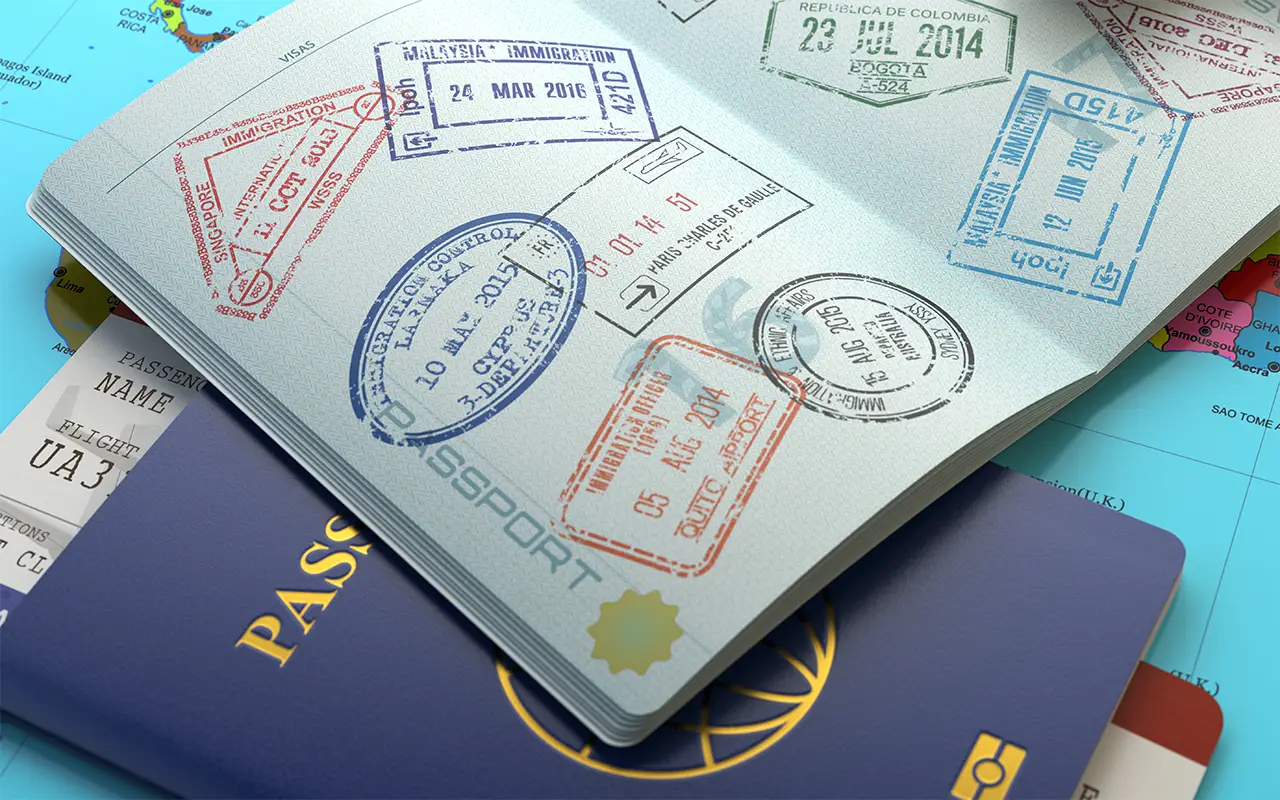Check visa-free destinations for your passport

Singapore
Visa-free destinations:
195

South Korea
Visa-free destinations:
193
Spain
Visa-free destinations:
193
Italy
Visa-free destinations:
193
Germany
Visa-free destinations:
193
France
Visa-free destinations:
193

United Kingdom
Visa-free destinations:
192
Sweden
Visa-free destinations:
192
Netherlands
Visa-free destinations:
192
Japan
Visa-free destinations:
192
Finland
Visa-free destinations:
192
Luxembourg
Visa-free destinations:
191
Denmark
Visa-free destinations:
191
Austria
Visa-free destinations:
191
Switzerland
Visa-free destinations:
190
Portugal
Visa-free destinations:
190

Norway
Visa-free destinations:
190
Ireland
Visa-free destinations:
190
Belgium
Visa-free destinations:
190

United States of America
Visa-free destinations:
189

New Zealand
Visa-free destinations:
189
Greece
Visa-free destinations:
189
Canada
Visa-free destinations:
189

Australia
Visa-free destinations:
189
Malta
Visa-free destinations:
188
Hungary
Visa-free destinations:
187
Czech Republic
Visa-free destinations:
187
Poland
Visa-free destinations:
186

Slovakia
Visa-free destinations:
185

Iceland
Visa-free destinations:
185
Estonia
Visa-free destinations:
185
Slovenia
Visa-free destinations:
184
Lithuania
Visa-free destinations:
184
Liechtenstein
Visa-free destinations:
184
Latvia
Visa-free destinations:
184

Malaysia
Visa-free destinations:
182
United Arab Emirates
Visa-free destinations:
180
Monaco
Visa-free destinations:
180
Cyprus
Visa-free destinations:
178

Croatia
Visa-free destinations:
177
Romania
Visa-free destinations:
176

Hong Kong
Visa-free destinations:
176
Chile
Visa-free destinations:
176
Bulgaria
Visa-free destinations:
176
Argentina
Visa-free destinations:
173

San Marino
Visa-free destinations:
172
Brazil
Visa-free destinations:
172

Andorra
Visa-free destinations:
172

Brunei
Visa-free destinations:
168

Israel
Visa-free destinations:
166

Barbados
Visa-free destinations:
165

Mexico
Visa-free destinations:
160
Bahamas
Visa-free destinations:
157

Vatican City
Visa-free destinations:
156

Uruguay
Visa-free destinations:
156
Seychelles
Visa-free destinations:
155

Saint Kitts and Nevis
Visa-free destinations:
154

St. Vincent and the Grenadines
Visa-free destinations:
152

Antigua and Barbuda
Visa-free destinations:
152
Ukraine
Visa-free destinations:
150
Mauritius
Visa-free destinations:
150
Trinidad and Tobago
Visa-free destinations:
149
Costa Rica
Visa-free destinations:
149

Paraguay
Visa-free destinations:
147

Macao
Visa-free destinations:
146

Taiwan
Visa-free destinations:
144
Saint Lucia
Visa-free destinations:
144
Panama
Visa-free destinations:
144

Grenada
Visa-free destinations:
143
Peru
Visa-free destinations:
141

Dominica
Visa-free destinations:
141

Serbia
Visa-free destinations:
135

Guatemala
Visa-free destinations:
135
El Salvador
Visa-free destinations:
135
Colombia
Visa-free destinations:
135

Honduras
Visa-free destinations:
134

Solomon Islands
Visa-free destinations:
132

Samoa
Visa-free destinations:
130

North Macedonia
Visa-free destinations:
128

Nicaragua
Visa-free destinations:
128

Tuvalu
Visa-free destinations:
125

Montenegro
Visa-free destinations:
125

Georgia
Visa-free destinations:
125
Tonga
Visa-free destinations:
124

Venezuela
Visa-free destinations:
123

Moldova
Visa-free destinations:
123

Marshall Islands
Visa-free destinations:
123

Kiribati
Visa-free destinations:
122
Palau
Visa-free destinations:
121
Micronesia
Visa-free destinations:
120

Bosnia and Herzegovina
Visa-free destinations:
120

Albania
Visa-free destinations:
119
Turkey
Visa-free destinations:
118
Russia
Visa-free destinations:
116

South Africa
Visa-free destinations:
105
Qatar
Visa-free destinations:
103

Belize
Visa-free destinations:
99
Timor-Leste
Visa-free destinations:
97
Kuwait
Visa-free destinations:
97

Ecuador
Visa-free destinations:
94
Maldives
Visa-free destinations:
92

Vanuatu
Visa-free destinations:
90

Fiji
Visa-free destinations:
89

Guyana
Visa-free destinations:
88
Nauru
Visa-free destinations:
87
Botswana
Visa-free destinations:
87

Saudi Arabia
Visa-free destinations:
86

Jamaica
Visa-free destinations:
86
Bahrain
Visa-free destinations:
86

Oman
Visa-free destinations:
84

Papua New Guinea
Visa-free destinations:
83

China
Visa-free destinations:
82

Belarus
Visa-free destinations:
82
Thailand
Visa-free destinations:
80
Indonesia
Visa-free destinations:
79
Suriname
Visa-free destinations:
78

Kosovo
Visa-free destinations:
78

Namibia
Visa-free destinations:
77
Lesotho
Visa-free destinations:
77
Bolivia
Visa-free destinations:
77

Kazakhstan
Visa-free destinations:
76

Eswatini
Visa-free destinations:
75
Malawi
Visa-free destinations:
72

Kenya
Visa-free destinations:
72
Tanzania
Visa-free destinations:
71

Dominican Republic
Visa-free destinations:
70

Azerbaijan
Visa-free destinations:
70
Armenia
Visa-free destinations:
70

Zambia
Visa-free destinations:
69
Tunisia
Visa-free destinations:
68
Gambia
Visa-free destinations:
68

Uganda
Visa-free destinations:
67
Morocco
Visa-free destinations:
67

Cape Verde
Visa-free destinations:
65

Philippines
Visa-free destinations:
65
Sierra Leone
Visa-free destinations:
64

Mongolia
Visa-free destinations:
64
Ghana
Visa-free destinations:
64

Zimbabwe
Visa-free destinations:
63

Rwanda
Visa-free destinations:
63

Mozambique
Visa-free destinations:
62
Sao Tome and Principe
Visa-free destinations:
61

Kyrgyzstan
Visa-free destinations:
61
Benin
Visa-free destinations:
61
Madagascar
Visa-free destinations:
60

Uzbekistan
Visa-free destinations:
59
Gabon
Visa-free destinations:
59

Cuba
Visa-free destinations:
59

Tajikistan
Visa-free destinations:
58

India
Visa-free destinations:
58
Burkina Faso
Visa-free destinations:
58
Togo
Visa-free destinations:
57
Côte d’Ivoire (Ivory Coast)
Visa-free destinations:
56

Guinea
Visa-free destinations:
56
Equatorial Guinea
Visa-free destinations:
56
Niger
Visa-free destinations:
55
Mauritania
Visa-free destinations:
55
Senegal
Visa-free destinations:
54

Comoros
Visa-free destinations:
54
Mali
Visa-free destinations:
53

Guinea-Bissau
Visa-free destinations:
53
Chad
Visa-free destinations:
53

Cambodia
Visa-free destinations:
53
Jordan
Visa-free destinations:
52

Central African Republic
Visa-free destinations:
52

Bhutan
Visa-free destinations:
52
Algeria
Visa-free destinations:
52
Egypt
Visa-free destinations:
51
Cameroon
Visa-free destinations:
51
Vietnam
Visa-free destinations:
50

Angola
Visa-free destinations:
50

Haiti
Visa-free destinations:
49
Congo
Visa-free destinations:
49

Turkmenistan
Visa-free destinations:
48
Laos
Visa-free destinations:
48
Djibouti
Visa-free destinations:
48

Burundi
Visa-free destinations:
48

Liberia
Visa-free destinations:
47
Nigeria
Visa-free destinations:
45

Congo (Dem. Rep.)
Visa-free destinations:
44

South Sudan
Visa-free destinations:
44
Lebanon
Visa-free destinations:
44

Iran
Visa-free destinations:
43

Ethiopia
Visa-free destinations:
43
Myanmar
Visa-free destinations:
42
Sudan
Visa-free destinations:
41

Sri Lanka
Visa-free destinations:
41

North Korea
Visa-free destinations:
39

Libya
Visa-free destinations:
39

Eritrea
Visa-free destinations:
39

Nepal
Visa-free destinations:
37
Bangladesh
Visa-free destinations:
37
Palestinian Territories
Visa-free destinations:
35
Somalia
Visa-free destinations:
35
Yemen
Visa-free destinations:
34
Pakistan
Visa-free destinations:
33

Iraq
Visa-free destinations:
30
Syria
Visa-free destinations:
27

Afghanistan
Visa-free destinations:
26




